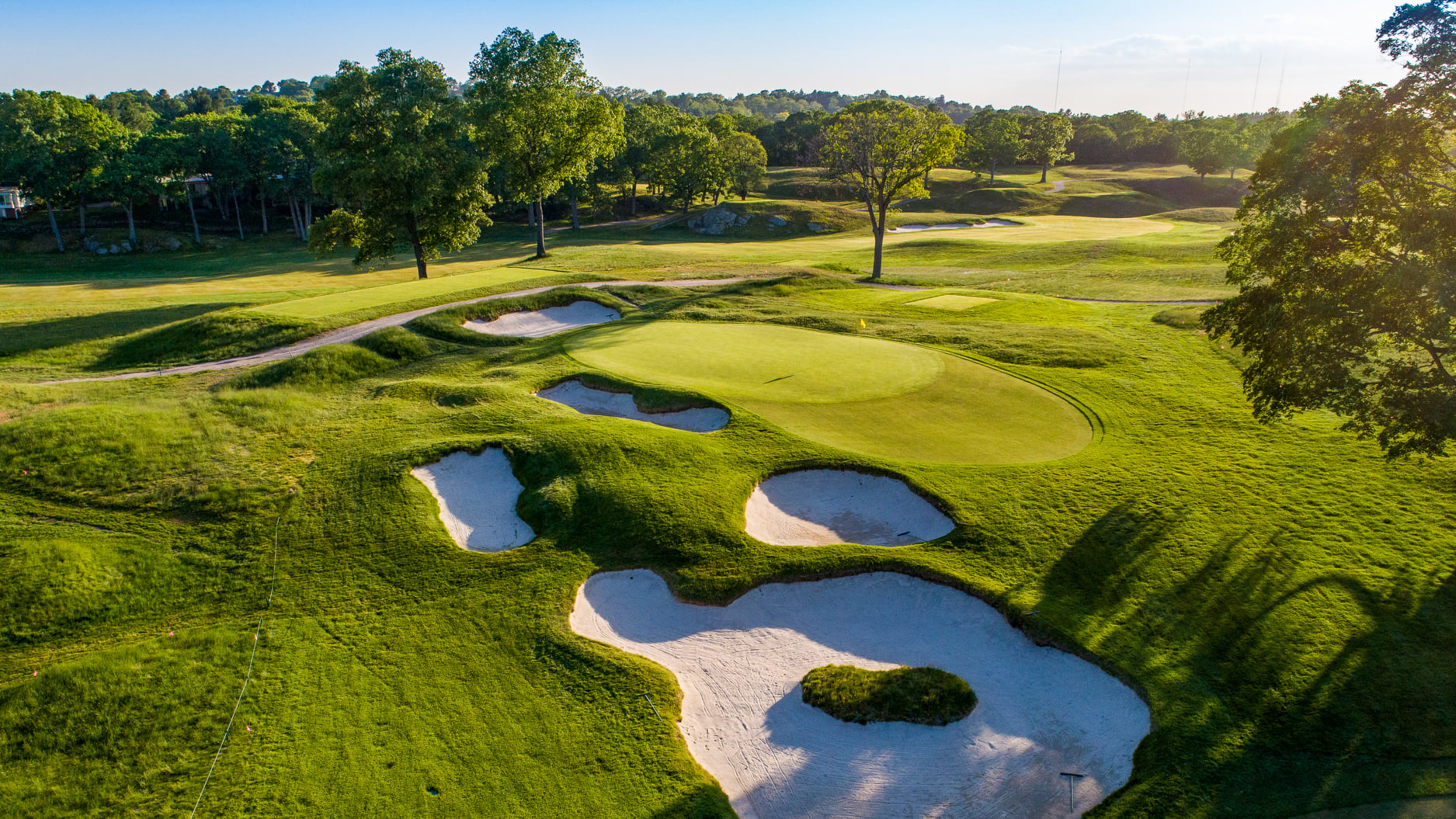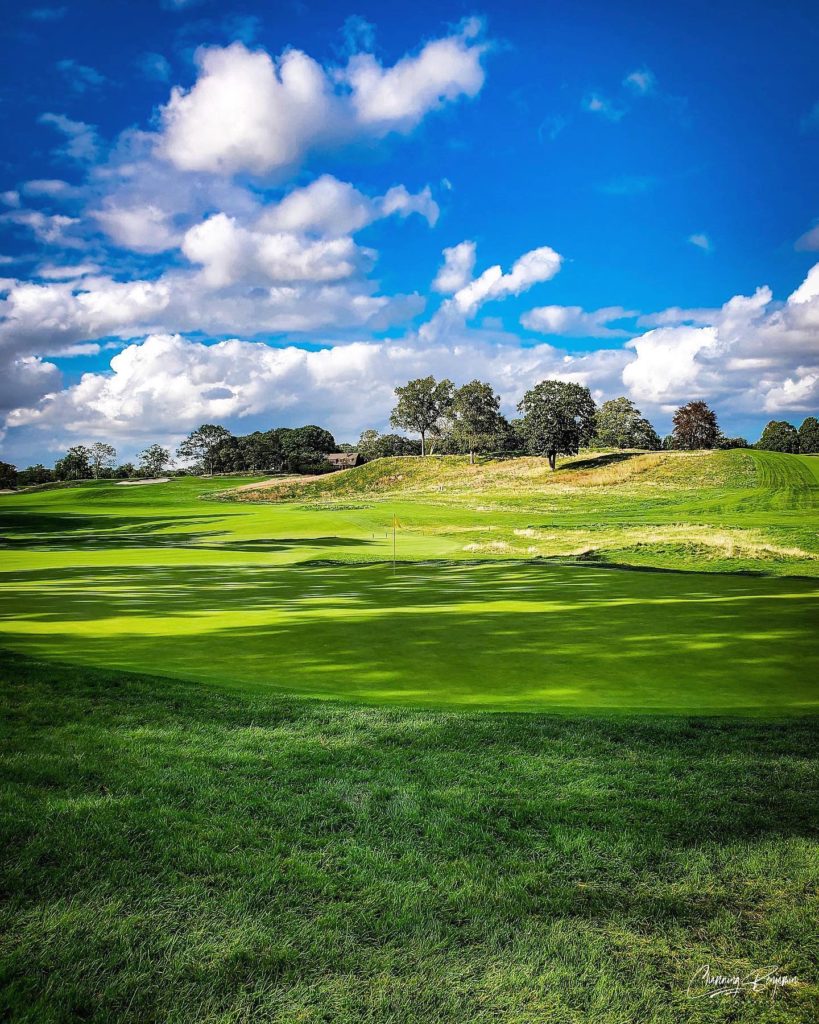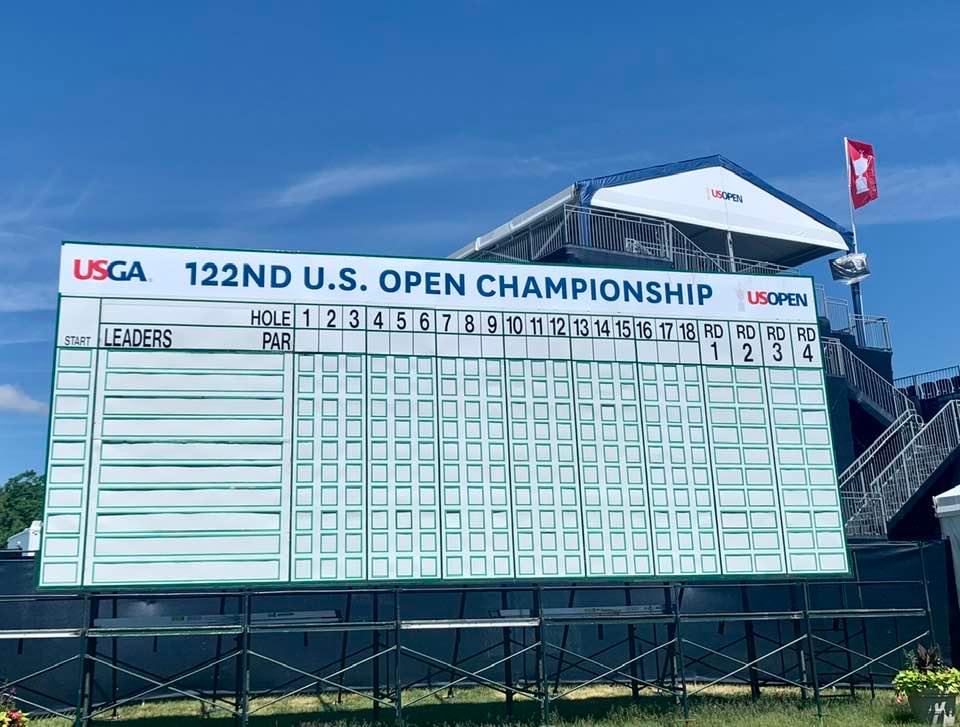
If you are a golfer or golf fan, you’ve likely seen the film “The Greatest Game Ever Played,” a based-on-fact account of the 1913 U.S. Open played at The Country Club in the leafy Boston suburb of Brookline. In that rendition of America’s national golf championship, local amateur Francis Ouimet outlasted professionals Harry Vardon and Ted Ray in a playoff and turned the golf world on its proverbial ear.
The U.S. Open returns to The Country Club on June 16-19, marking the first time since 1988 that a golf major will be held in the Boston area.
The course that the 156-player field will try to tame bears little resemblance to the one that was originally laid out before the turn of the 20th Century. It’s even different from the routing used for the 1963 and 1988 U.S. Opens, which were won by Julius Boros and Curtis Strange, respectively.
And it differs from the track used for the 1999 Ryder Cup that was emblazoned in our collective memory by Justin Leonard’s twisting, turning long putt that capped the U.S. team’s historic Sunday comeback win.
This newest routing utilizes 14 holes from The Country Club’s Main Course (a combination of the Clyde and Squirrel nines) and four holes from the Primrose nine, which was added into the club in 1927. This year’s Open includes a hole not utilized in a major since 1913.

The Country Club
A history lesson
The name of The Country Club is apt: it was the first “country club” in the United States, a getaway in the woods located southwest of town for Beantown’s well heeled.
The Country Club’s first holes were routed in 1893 and holes were changed over the next two decades, primarily by a group of the club’s members, as more land nearby was purchased. The only remaining hole from the first nine-hole layout is the par-3 seventh.
The course is built on, over and through rock outcroppings, and the holes run up and down and around mounds that create blind shots and canted lies throughout.
The Country Club’s Main Course (which is ranked the 17th best course in the United States by Golf Digest) plays as a par-70 and at just 6,930 yards but nearly every hole ends at tiny, sloping greens that are surrounded by long grass.
The Country Club’s putting surfaces are second only to Pebble Beach’s among the smallest in major-championship golf. They now average just under 4,400 square feet (Pebble Beach’s comes in at an average of 3,900 square feet). Most have breaks that move across the slopes and slide forward with various degrees of left or right break.
The Country Club is located on a beautiful inland piece of property and is chock full of incredible history and tradition. Memorable holes abound here, with the challenge dictated by the movement of the terrain, the bunkering and length of the ever-present fescue.
Let’s take a look at the Main Course at The Country Club – the layout used on a daily basis by the members of this uber-exclusive club that has changed little since the early 1900s – and give a shout out to where the changes have been made for this year’s U.S. Open.
Blind shots add to the test at The Country Club
While many golf courses play through the terrain, the Main Course at The Country Club tackles its obstacles head on and goes right over the top of whatever was put in its way.
The opening hole (a 495-yard par-4) is a difficult dogleg left, lined by the practice green to the right and range on the left. Two bunkers line the left side of the dogleg between 220 and 250 yards. The putting surface runs back-to-front and is surrounded by a trio of bunkers on either side.
The 504-yard par-4 third hole might be the best hole at The Country Club, with a fairway that weaves through a harshly undulating piece of property, pinches down between outcroppings to a wasp-waist gap of just 10 yards and then finishes delicately in front of a pond. The drive needs to be aimed out to the left (to the right of the left-hand fairway bunker) to a find a flat area for the approach.
The fourth is carded at just 335 yards, with a tee box at the bottom of the hill and the drive is over a giant mound of fescue, making it completely blind. The fairway here is initially generous but narrows at about 210 yards with bunkers on the left. The green is one of the smallest on the course lined by six narrow, deep bunkers.
The Country Club’s most difficult hole, the fifth, is also one of its finest. This nearly 497-yard beast features a blind tee shot. Open space is offered to the left off the tee but introduces a much longer approach shot on this dogleg right. A pair of cross bunkers comes into play well short of the green while another pair of bunkers flank the left side of the green.
The sixth is a 310-yard par-4 that goes uphill to a fairway that slopes left to right; it is probably the easiest hole on the front nine. With out-of-bounds and a trio of bunkers lining the right, this reachable hole plays towards another minuscule green. There are four giant bunkers guard just short.
The seventh hole claims its status as the signature hole at The Country Club because of its challenge and the fact that it is the oldest hole on the property. The raised green features a challenging double plateau and is protected by huge bunkers to both the left and right.
The Country Club has a great collection of short par-4s, and the 334-yard 10th is no exception. It’s an incredibly quirky hole that can lead to big numbers quickly. Your drive must find a tight fairway lined by prominent bunkers on both sides and by trees past the sand. In true old school fashion, the front of this putting surface is almost completely obscured by a mound.
The course only has two par-5s, but they certainly aren’t lacking in quality. The 11th hole is one of the best holes on the course. At 513 yards, the tee shot plays downhill over a creek on this long, winding, uphill double-dogleg. The hole is also notable for its glacial rock formation that narrows the fairway at about 240 yards. Those short of the rocks will have a blind second shot, while longer hitters will be able to aim left over them. The green sits at the far-right corner on a pedestal guarded by numerous deep bunkers.
The 131-yard 12th will finally get its time in the spotlight as it’s been added to the U.S. Open routing for the first time. Its green was reworked by a renovation by Gil Hanse to add hole locations. It’s a little flip wedge, but a really fun hole due to the downhill nature and the trouble all around the green, which had a back-to-front slope. There are more 5s than 2s here.
The par-4 478-yard 13th is another strong hole. Heavily tree-lined, this hole is played to an uphill fairway that plateaus at about 240 yards with a hidden cross bunker on the right to be avoided and was only recently added by Gil Hanse. The approach here is one of the most beautiful on the course with water down the right and a back-to-front sloped putting surface guarded by two bunkers short.
The final five holes are the same for both the Main Course and U.S. Open rota beginning with the par-5 14th. At 567 yards, this is the longest hole at The Country Club. It’s a broad, sweeping dogleg-left that sports mounds of rough on both sides of an undulating fairway. The approach narrows considerably towards an elevated green guarded by a penal false front.
The 15th is played downhill and straightaway. The 515-yard par-4 traverses a rocky terrain off the tee to a generous fairway lined by OB left and the majestic yellow clubhouse on the right. The Club’s driveway bisects the fairway at 270 yards; this approach plays flat and open into a larger, relatively flat green guarded by bunkers on three sides.
The 205-yard 16th is the final par-3 on the course and finishes at a small and putting surface guarded by four bunkers.
The 17th hole lives in the history books forever as the deciding hole in the 1913 and 1963 U.S. Opens and 1999 Ryder Cup. This slender 370-yard dogleg left is protected by four giant bunkers (AKA: Vardon’s bunkers) at the inside elbow of the dogleg. The putting surface is one of the narrowest on the course, protected by a tall tree to the right and multiple deep bunkers on both sides. It’s possibly the most undulating green on the course.
At 455 yards, the difficult closing hole is a dogleg left that’s gently treed with hidden bunkers down the left side. The approach must carry a cavernous “principal’s nose” bunker short of a circular green that runs hard back-to-front.

Changes for the U.S. Open
The USGA has said The Country Club will play 250 yards longer at 7,264 yards, and it will play as a par-70 for this year’s U.S. Open. It was a par-71 in 1963 and 1988. The Country Club was a par-73 when it first hosted the U.S. Open in 1913.
This year’s championship course will add the 12th hole from the main course, a par-3 at 131 yards, and lose No. 4. Four other holes have notable changes – a pair take new positions in the routing, and two swap par. The holes that will play as Nos. 8 and 9 were No. 14 and No. 13, respectively, in 1988.
The swap balances the nines and facilitates the Nos. 1 and 10 tee start needed for Rounds 1 and 2 (the two-tee start wasn’t a factor in 1988; it debuted in the 2002 U.S. Open).
The holes that change par are No. 10 (from 5 to 4) and No. 14 (from 4 to 5). The 14th played as a 450-yard par-4 in 1988 and has been transformed to a 619-yard par-5. The 10th was a 510-yard par-5 in 1988 and is now a 499-yard par-4. The changes add a degree of difficulty from 1988. Both of the reconfigured holes made their USGA debuts in the 2013 U.S. Amateur, won by Matthew Fitzpatrick of England.
History in spades
The Country Club is a spectacular and demanding course. It’s a design where the golfer with the best short game and strategy beats the bomber every time, and that fact has been proven daily as well as in its U.S. Open history.
You can make the argument that no other golf course in America has a richer or more important history than The Country Club. Tradition just oozes out of the ground at this place and a historical presence is tangible in every corner of the property. As length renders many classic courses obsolete, the strategic bunkering and tiny greens here make this a true championship venue that has withstood the test of time.

Pinehills
Some top resort/public courses in Massachusetts
While you’re likely to have quite a tough time playing The Country Club, here’s some resort and public courses in Massachusetts that you can get on and enjoy:
- Ocean’s Edge Resort & Golf Club, Brewster (Cape Cod)
The combination of grand accommodations in the classic style and superb golf on a testy course make Ocean Edge an experience that must be enjoyed first-hand. It’s a turn-of-the-century golf vacation right out of the story books, with the added flair of modern conveniences and a revitalized golf challenge fashioned by Nicklaus Design.
- Wequassett Resort and Golf Club, Harwich (Cape Cod)
Golfers might say the best thing about Wequassett is access to the adjacent Cape Cod National Golf Club, which is one of the area’s finest courses. The Brian Silva-designed track has played host to a number of United States Golf Association, including the U.S. Amateur Championship. The main lodge here is surrounded by cedar-shingled cottages of various design and dimension. Each building is shrouded by trees and shrubs and linked by red brick pathways. It feels very rural, but the beach and bay views remind guests of its coastal location.
- Pinehills Golf Club, Plymouth
This facility offers a pair of championship golf courses designed by Rees Jones and Nicklaus Design. Be ready for some wildly hilly terrain among hundreds of acres of thick pine trees on both courses. The Nicklaus course plays a bit wider and allows for more free swinging off the tee than the Jones-designed track. Each has plenty of forced carries over fescue, forest, or water that can make some holes really tough for high handicappers. Stay right down the road at the sublime Mirbeau Inn & Spa Plymouth.
- Miacomet Golf Course, Nantucket Island
The 18-hole course, which co-hosted the 2021 U.S. Mid-Amateur Championship, has dangerously fast greens and is widely recognized as one of the top public courses in the region. Designed by Howard Maurer, it is challenging yet playable for of all levels of player. It’s Nantucket Island’s only 18-hole public golf facility and is located one mile from the ocean and three miles from town.
- George Wright Golf Course, Hyde Park
Operated by the city of Boston and set about 30 minutes from downtown, George Wright Golf Course was designed by Donald Ross and built by Ross associate Irving Johnson in 1938 after receiving Workers Progress Administration (WPA) funding to complete the construction. It’s a fine early example of serious earth moving in course design. In recent years, George Wright Golf Course has been chosen as Golf Digest’s Best Municipal Course in Massachusetts and by Golfweek as the 14th Best Municipal Golf Course in the U.S.

